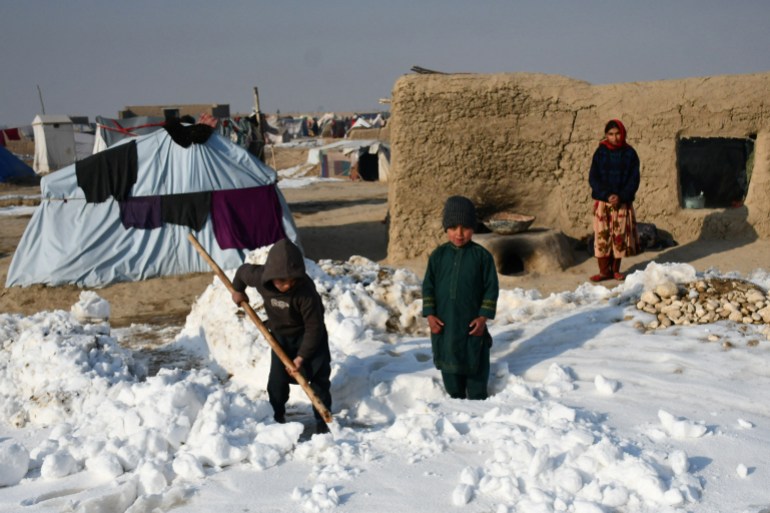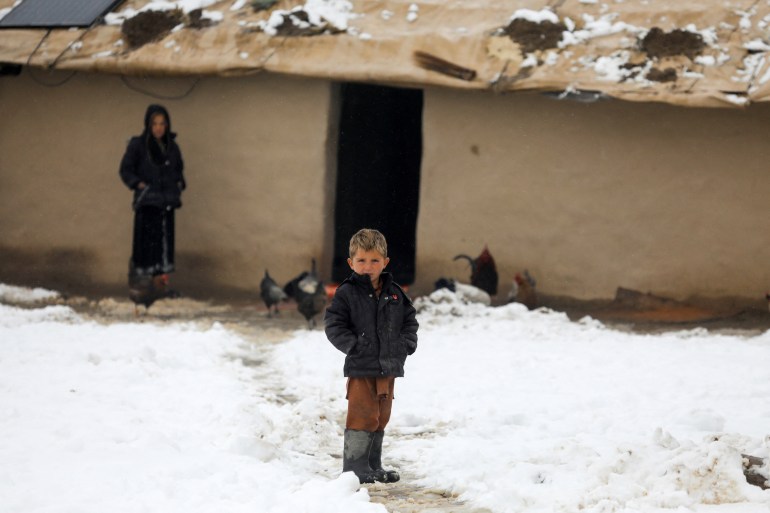Afghans braving severe cold face stark choice – food or warmth | Climate Crisis News
The youngest of Shah Ibrahim Shahin’s children sit huddled next to each other on the thin “toushaks” – traditional Afghan floor mattresses – trying to stay warm amid freezing weather. The adults, wrapped in thread-bare woollen clothes, surround them in a small chilly room, which makes up the entirety of their home, in the northern Afghan province of Baghlan.
Many provinces in Afghanistan have seen an exceptionally cold winter in the last two weeks, with temperatures dropping to as low as -21 degrees Celsius (-5.8 Fahrenheit) in Kabul. More than 20 people have died due to the cold wave, according to media reports.
At its warmest, the temperature in Baghlan on Friday was 11 degrees below zero. And without access to affordable heating, all that Shahin and 14 members of his family, including his 10 children, have is each other for comfort in the frigid cold.
“We have one bukhari [a traditional coal heater]; we purchased some coal at the start of the winter, but in this [cold] weather, our supply is almost over, and we cannot afford any more,” the 54-year-old Shahin told Al Jazeera, sitting inside the nippy room.

Shahin, a taxi driver by profession, has been out of work for almost a year. The country’s new Taliban rulers have struggled to revive the economy for more than 18 months since they returned to power. Their government, still facing international isolation, has been unable to cope with rampant poverty and a humanitarian crisis.
While the 54-year-old struggled to make ends meet, a medical crisis in his family put him in severe debt, and the dwindling business meant that he could no longer afford the fuel needed to drive his car.
The determination and will of government authorities to help our fellow Afghans can be seen in this video. There is no other good deed in Afghanistan than helping the people of Afghanistan. pic.twitter.com/q2qr6Oa4Ne
— Muhammad Jalal (@MJalal700) January 13, 2023
“Two of my sons work as day labourers, but they don’t make more than 150 Afghanis ($1.68) a day; not even enough to buy food for the day. It has been months since we tasted a fruit or meat,” he said.
Located at the foot of the formidable Hindu Kush mountains, their town is no stranger to harsh winter. In fact, the heavy snow replenishes groundwater and can be beneficial to agriculture.
“We are happy it is snowing, it is a gift from God and it will be useful for wells and farmers, but we are very concerned about how will we stay warm as the temperatures fall,” Shahin says. “We can barely afford to buy food,” he added solemnly.
Weather anomalies
In the neighbouring Samangan province, a 25-year-old Afghan mother of two faced stark choices – buy coal or food.
“If we buy coal and wood, then we won’t be able to buy food. The money my husband sends us is not sufficient to even cover basic requirements,” Maryam told Al Jazeera. Her husband works in a neighbouring country.
As the wife of a former soldier with the US-backed Afghan government, she requested anonymity to avoid Taliban reprisal.
“After the fall of Kabul, my husband was hunted by the Taliban and had to escape to a neighbouring country. For a while, we survived on his savings, and then on charity. He sends us money when he has work, but we can’t afford a bukhari this winter,” she said.

Instead, they relied upon a “sandali” – a wooden table-like structure that can hold a small heater and is covered with a large quilt to trap the warmth.
“This is the only thing that we have but it never gets hot enough because we can’t afford even a little wood [for the small heater in the sandali]. I usually use discarded plastics and papers, which doesn’t last a very long time,” Maryam said. “This is the coldest winter of my life, and I don’t know how we will survive it without food or heat,” she added.
Taliban has rescued civilians trapped in remote locations after heavy snowfall, according to media reports.
The extreme winter has already compounded the misery of Afghans who are already suffering from an unprecedented humanitarian crisis, affecting 28 million people, according to the latest figures from the UN Office for the Coordination of Humanitarian Affairs (OCHA).
Climate scientists have attributed the recent weather anomalies to polar vortex disruptions, “as a result of which, strong arctic winds flow much farther from the North Pole and bring masses of cold air to our region,” explained Najibullah Sadid, an Afghan climate expert and associate researcher at the University of Stuttgart.
He shared that prediction models estimated that the cold wave would last until the end of January or the first week of February, before the weather returns to average conditions.
“Afghanistan, like other countries, is witnessing a rise in the number of extreme events. This is much to do with climate change as more sun energy is observed by the Earth’s atmosphere that in turn increases the dynamic of atmospheric activities such as heatwaves, rapid rains, etc,” he said, adding that a lack of preparedness for such events could have disastrous consequences for Afghans.
Suspension of NGO services
International sanctions and banking restrictions imposed on the Taliban when they took over the country in August 2021 have triggered an economic crisis, propelling an already distressed country into catastrophe.

Meanwhile, increased restrictions from the Taliban, particularly on female aid workers, have prompted many international NGOs working in the country to suspend their services.
“Since we have been forced to suspend all our operations due to the ban on female NGO staff, we are not currently able to assist any people in need. The situation is very serious,” said Christian Jepsen, regional communications adviser at Norwegian Refugee Council (NRC).
For many Afghans, the services provided by the international aid organisations were a lifeline that has been removed at the worst possible moment.
“We receive a monthly package of flour, oil and beans from an NGO. It is not enough for our large family, but if it stops, we will die from cold and starvation,” Shahin said, appealing to non-governmental organisations to remain open during the winter.
NGOs, such as NRC, have appealed to the Taliban to “find a way that will allow humanitarian operations to resume with both men and women assisting”.
“Our female colleagues have very important roles both in our offices, and in fieldwork with direct contact with people we serve. Humanitarian operations across Afghanistan have been adversely affected by this irresponsible decree,” Jepsen said.
Some NGOs have resumed work after assurances that women will be allowed to work.
Sadid, the Afghan climate expert, also urged the Taliban authorities to provide forecasts and raise awareness among Afghans to help them cope with severe weather.
“Most Afghans live in remote valleys where connecting roads are often blocked by heavy snowfalls. Model predictions can help people avoid commuting during the extreme cold events and plan for it,” he said, adding that such information and awareness could also help the survival of livestock in open areas.

Pingback: Brenda
Pingback: Al-Yarmok University College